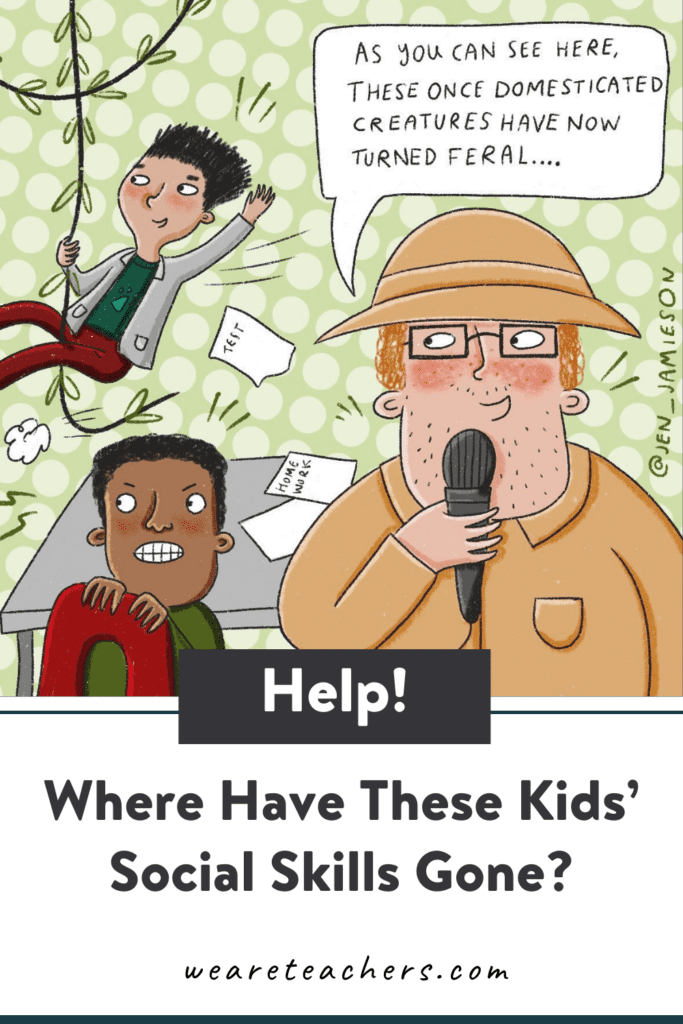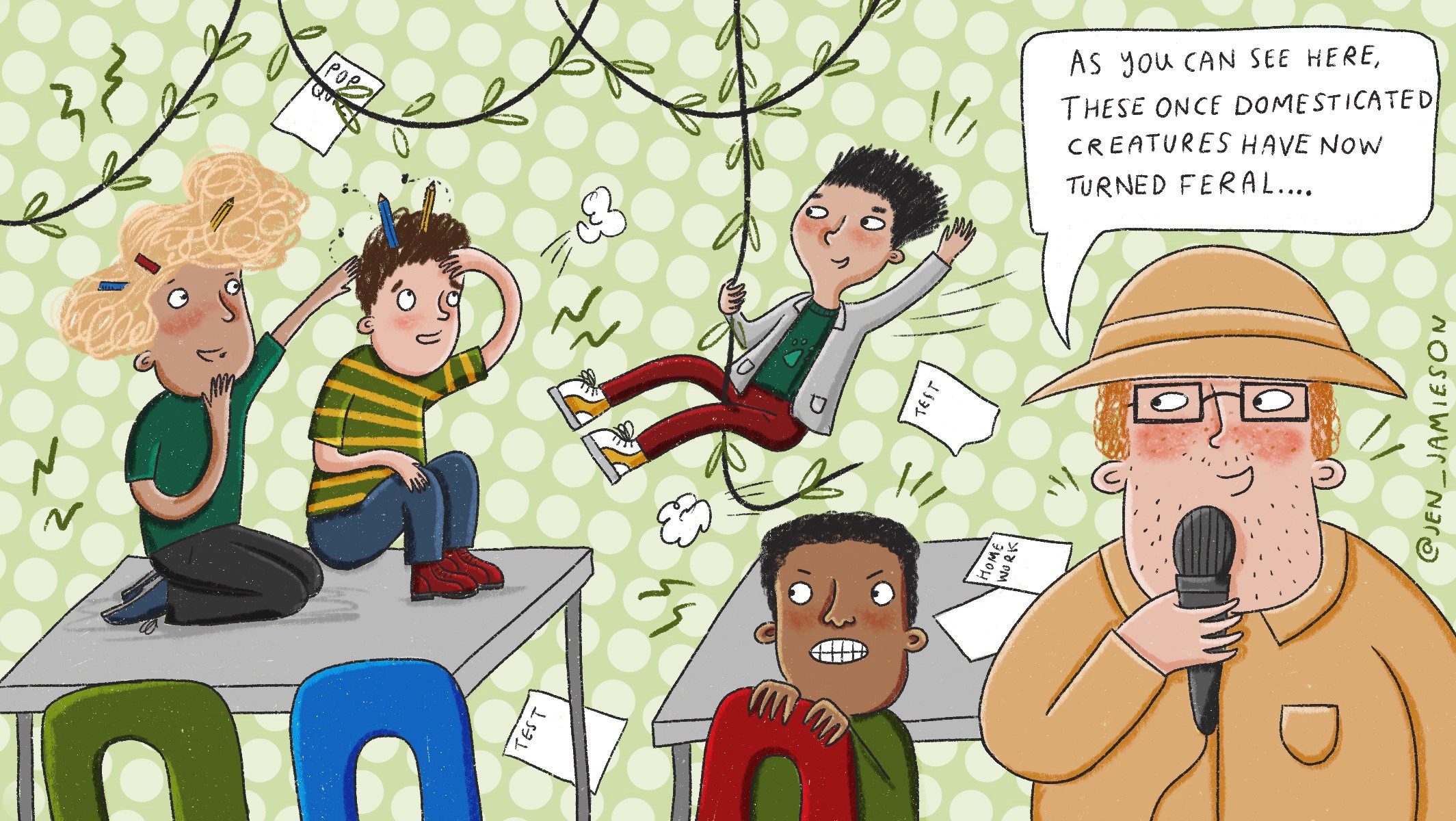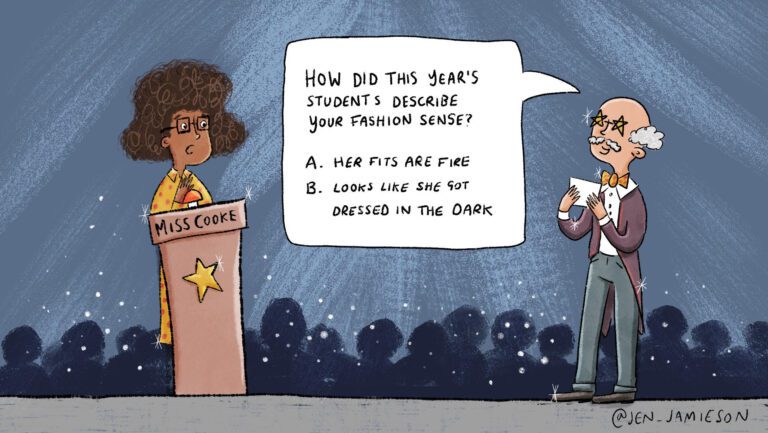Dear WeAreTeachers:
Is it just me, or do these kids not have the same social skills as in years past? I know that our students were out of in-person school for almost two years. There are definitely gaps in their learning, but it’s their lack of social skills that is really causing a problem in the classroom. They interrupt me and one other constantly. They’re rude to school staff and even their friends. Most of the kids don’t know how to sit still. And it seems like it’s gotten especially bad in this lead-up to Winter Break for this group of 2nd grade kids. What can I do? —Social Skill Frenzy
Dear S.S.F.,
How many educators reading your post are also nodding their heads? A lot. I’m sure of it. When we reflect on the past two years of stressors due to COVID, it’s not surprising we are in this place with so many of our learners. It can feel discouraging to witness students treating each other abrasively. It’s also exhausting to intentionally plan your lessons only to have your hard work hijacked by disruptive behaviors. So, what can we all do? Let’s refresh some practical ideas that build social skills to promote a classroom community embodied by respect. Of course, the behaviors won’t change overnight, but the only thing to do is to accept reality, adjust, and address students at their points of need.
First, we can take a moment to reflect on our own teacher presence. Author Lisa Delpit coined the term “warm demander” as a way of being for teachers. Warm demanders are teachers who “expect a great deal of their students, convince them of their own brilliance, and help them to reach their potential in a disciplined and structured environment.”
The team at June Jordan School for Equity in San Francisco came up with four dispositions that help teachers become warm demanders. The first idea is to believe in the impossible and maintain the stance that ALL of your students are capable of learning. These rude behaviors you all are experiencing can change. Next, invest time and attention to create a culture of trust. Trust begins and is fortified when we REALLY listen to the kids and learn about who they are and what matters most to them. Another warm demander characteristic is to teach self-discipline and reinforce that success takes hard work. Finally, remember to embrace failure and reinforce that we learn through our mistakes. With perseverance, these warm demander dispositions will little by little shape the unruly behaviors you are witnessing.
Let’s start by circling up your students every day and being honest and clear with them about why social skills matter. Keep this time sacred in your schedule. This will send the message that you are committed to creating a more positive classroom culture. Be firm that the rude behaviors need to change. Explain that every single person in this classroom and school deserves respect. Consider charting what respect sounds, looks, and feels like. Keep the charting and ideas growing over time. Review the chart daily and add to it when ideas are sparked. It’s powerful to have students identify ways they are respectful each day. Also, encourage the kids to identify one thing they are working to improve.
Incorporate journaling with drawing and writing as a way to gauge your students’ level of awareness and progress. Ask kids to write about how they feel in your class and at school. You might start noticing patterns that you can address in your daily class meetings. Harvesting ideas from your students’ writing is an authentic way to make kids feel seen and heard. Of course, keep the ideas anonymous so that the space you create is both brave and safe. Also, dedicate time for students to write and talk about how it feels when someone interrupts them. Read aloud students’ ideas to build awareness and hopefully some empathy and compassion. And share the read-aloud text Interrupting Chicken ASAP!
We need to get the kids to care about each other and respect the diverse perspectives that make up the beautiful kaleidoscope of your classroom. In our current reality, COVID has brought about so much divisiveness in the political arena and beyond. Kids see adults acting impatient, critical, cruel, and rude on television and in many other spaces. Schools are places where we can reframe and build hope and unity one conversation at a time. Nicole Eredics, a contributing author to Reading Rockets, reminds us that “inclusive classrooms are representations of the real world where people of all backgrounds and abilities co-exist.” So, let’s stick with it even when progress feels itty bitty. Let’s keep moving forward the best we can.
Dear WeAreTeachers:
The latest gun violence at a school in Michigan has me remembering the other school shooting tragedies. My anxiety is through the roof! My 4th graders are asking me questions about active shooters, and I can tell they feel scared. Our school is good about doing the drills, but it also freaks out some of the kids. It’s the first time in my 20-year career as a teacher where I don’t feel like I can look a student in the eye and tell them they are safe here at school. How should I address the questions they ask about these traumatic school shooting events. —What Can I Do?
Dear W.C.I.D.,
Imagining the terror that students and staff experience during a school shooting is absolutely horrifying and anxiety-inducing. It’s astounding that since 2009, there have been 288 active shooter tragedies in U.S. schools compared to a handful of school shootings in Germany, Canada, Japan, Italy, and the U.K. combined. It’s understandable that you are feeling anxious, heavy-hearted, and unsure of how to respond to questions around school shootings.
The Washington Post has been keeping track of U.S. school shooting data and found that “more than 278,000 students have experienced gun violence at school since Columbine … Beyond the dead and wounded, children who witness the violence or cower behind locked doors to hide from it can be profoundly traumatized.” We can assume that our youth are hearing and seeing information and images related to these violent events in the media. With all the exposure to gun violence comes fears, questions, and a wide range of reactions.
No matter what your opinion is around the debate on gun control, as teachers, we need to learn ways to navigate and shape the heartbreaking and maddening reality around school shootings in our country. Psychology Today describes several tips on supporting kids’ responses to gun violence. The author, Eugene Beresin, M.D, M.A., states the importance of learning to control our own anxieties as we talk to our students. Research has repeatedly shown that when adults show up with a calm demeanor to discussions, they are more effective in talking about issues that scare kids. So, go back to those deep breaths that magically bring about some spaciousness in your body. With the spaciousness, we can begin to experience a bit of calm.
Readers, please take this next tip from Dr. Beresin seriously and be action-oriented: “Keep your own home safe from gun violence. Knowing that around 1 in 3 homes with children contains at least one firearm, it is critical for gun-owning parents to safely store them away, ideally by locking up the unloaded gun and storing the ammunition in a separate locked location. If you think your children don’t know where you keep your gun(s) or that they know not to play with them, think again. Research and past experience have shown that too many accidental shootings occur in the home by making these assumptions.”
Be aware that the active shooter drills are important but also might be a trigger for students in your classroom. Take a moment to think about how a student might respond to an active shooter drill if they have experienced gun violence or police raids in their own home. Your hyper-vigilance and situational awareness of your students’ emotional states coupled with talks with students who exhibit concern make a world of difference. Make yourself available to your students, so they can talk about their emotions and experiences. Additionally, getting your school or district counselor involved is helpful. Consider asking for support and observing how a counselor talks to your students. The fact that you reached out for advice leads me to believe that you will be responsive. I imagine you are willing to hold space and listen to your students’ fears.
Hopefully, poet Emily Dickinson’s words resonate with you on the power of compassion.
If I can stop one heart from breaking,
I shall not live in vain;
If I can ease one life the aching,
Or cool one pain,
Or help one fainting robin
Unto his nest again,
I shall not live in vain.
Dear WeAreTeachers:
I’ve been a teacher for years, but I can’t help notice my students’ lives outside of school this year. We had a “fun fair” earlier this year. We are trying to get our students excited about being at school and create opportunities for the kids to be playful and have positive, shared experiences. While there was lots of fun and games, I did notice something that bothered me. One of my 3rd grade students rode her bike to the event alone. I was shocked to learn that she crossed a big, busy street to get to the event. I don’t know what steps I should take. What tips do you have? —Curious Not Critical
Dear C.N.C.,
Most of us are drawn to become teachers because we care about children. Yes, we want to ignite a love for learning, but we also have the desire to keep our students’ well-being at the forefront. It’s clear that you are conscientious and concerned about your students. From my viewpoint, it seems like your students are fortunate to have you in their lives.
If you believe your student is in danger, it’s a good idea to reach out to the family to let them know what you observed. Jessica Glass Kandorski highlights how a “good relationship fit for teachers and students is crucial, and of equal importance is the relationship between parents and teachers. A positive partnership between parents and teachers has far-reaching benefits. Research has shown students earn better grades, have more positive attitudes toward school, attend school more regularly, and engage in more positive behavior when their teacher and parents have a good relationship.”
When you do talk to the caregivers, be sure to communicate your ideas from a place of care over criticism. There are some mistakes to avoid when interacting with parents. For example, relying too much on one-way communication such as newsletters or online announcements can make it hard for families to have more open exchanges that involve problem-solving. Be sure to reach out to the parents to set up a time to talk. You might want to say something to the effect of, “I was so excited to see your child at the fair looking happy playing the games. I also wanted to share that I felt worried when I saw her cross the busy and dangerous street alone. I was wondering what thoughts you have. Maybe we can find out who else lives close by so the kids can support each other.”
Also, take the time to talk to the student one-on-one about safety. If the parents are allowing the child to ride her bike to school, you can be another influence to help your student make safe choices. Let the student know that you are talking to her because you want her to be safe on her bike, and she’s riding in some dangerous areas. Ask the student to share what she does to stay safe so you can find out her level of awareness and provide ideas based on what she contributes.
There’s a fine balance between giving kids freedom and being safe. A goal all of us educators have is to create opportunities where students build their self-awareness, confidence, and independence. Think about infusing safety talks into your classroom social-emotional meetings. Consider having various real-life scenarios, such as bike riding alone, where students can share their decision-making process with each other.
Shel Silverstein’s poem “Listen to the Mustn’ts” was a favorite of my 3rd grade students. This poem can be a spirited launching point for your classroom conversations, too:
Listen to the MUSTN’TS, child,
Listen to the DON’TS.
Listen to the SHOULDN’TS
The IMPOSSIBLES,
the WONT’S.
Listen to the NEVER HAVES,
Then listen close to me…
Anything can happen, child
Anything can be.
Dear WeAreTeachers:
I just had some much-needed time off, and it was wonderful. No anxiety or depression symptoms … I felt genuinely happy. But when Sunday rolled around, I woke up with my heart fluttering. I was just dreading going back to work. It’s like my body knew without even having to think about it. I am trying to enjoy the moment today, but I simply can’t. I am not sure I want to keep feeling this way or even return to teaching. “Remembering my why” doesn’t cut it anymore. —More Than The Sunday Blues
Dear M.T.T.S.B.,
So many of us can relate to having bumpy transitions from vacation breaks to returning to work. If you are feeling that sense of dread just a couple of times a year, that’s common for most of us. However, if you are feeling that heaviness more frequently, it’s helpful to set up a time with a therapist to get feedback and guidance.
Rebecca Fraster Thill prompts us to think about the onset of the vacation break and try to remember how long you are still thinking about work. She brings up that “many of us need a day or two to unwind from the pace of work, regardless of the quality of our job. But if you spend the majority of break rehashing work encounters and concerns mentally and/or while talking to others, or you find it impossible to tear yourself away from email because work’s always on your mind, it may be time to take notice.”
It’s great to hear that you are listening to the signs your body is communicating. Pay attention to them. Trust them. So many of us are in the process of learning to listen to our intuition and gut feelings. Intuition is that knowing that comes from instinctive feelings over consciousness and reasoning.
Writer and poet Padraig O Tuama writes:
Where do you feel
anxiety in your body?
The chest? The fist? The dream before waking?
The head that feels like it’s at the top of the swing
or the clutch of gut like falling
& falling & falling and falling
It knows something: you’re dying.
Try to stay alive.
If your dreadful feelings are lingering more and more and your joy is depleted, it’s OK to imagine possibilities other than teaching. All the learning you have internalized in your work as an educator has been worth it and is transferrable to other life contexts. Maybe you start exploring some possibilities and notice what makes you feel alive. And there’s no harm in setting yourself up with some therapy support so you can gain perspective about where your compass points.
I remember a time when I was visiting my dad during a break when he was suffering from Stage IV cancer. I said something like, “Ugh, I wish my break wasn’t over. I have to go back to work tomorrow.” He quickly chimed in, “You GET to work tomorrow.” This reframe has helped me to shift my attitude, but I still find that transitions after vacation breaks bring up sadness but also dread. My hope for you is that you take the next vacation break to take stock, protect time to be still, and listen to yourself.
Do you have a burning question? Email us at askweareteachers@weareteachers.com.
Dear WeAreTeachers:
One of my 9th graders’ parents emailed all the other parents in the class to complain about my class and the next novel we’re reading. I shouldn’t be surprised, but I am. Note, the parents didn’t say anything to me. So now several are riled up. And I need to figure out how to handle this. I do get their perspective. The book is intense and deals with a lot of heavy issues. I also stand by my choice to do it—to increase awareness and to put resources in the hands of kids. I also think that good literature can and should make you feel uncomfortable at times. What should I do?Love our advice column? Visit our Ask WeAreTeachers hub.
Illlustration: Jennifer Jamieson


